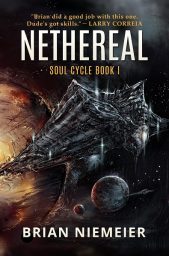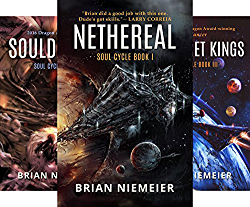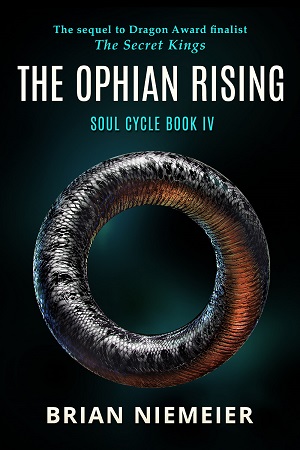Brian Niemeier is a best-selling science fiction author and a John W. Campbell Award for Best New Writer finalist. His second book, Souldancer, won the first ever Dragon Award for Best Horror Novel. He chose to pursue a writing career despite formal training in history and theology. His journey toward publication began at the behest of his long-suffering gaming group, who tactfully pointed out that he seemed to enjoy telling stories more than planning and adjudicating games.
Released this week, Brian’s newest book, The Ophian Rising, concludes his groundbreaking Soul Cycle series. Recently, I sat down with Brian to discuss The Ophian Rising, the rest of the Soul Cycle, and more. Part I of the interview focuses on the Soul Cycle.
* * * * *
You’ve mentioned on your blog that the Soul Cycle has been a passion project for you. What about it made it so riveting as a story to explore?
It’s kind of like trying to quantify love. Forgive me for going John C. Wright for a moment, but you kind of just asked me, “why do you love your favorite child?” I could point to how pleased I am with how the characterization has turned out and I could probably point to a few sequences in each book that I’m particularly proud of. It’s just in my wheelhouse. It’s the kind of project that I find esthetically pleasing. Like a lot of writers say, the Soul Cycle is the kind of sci-fi fantasy series that I always wanted to read but could never find, so I had to write it myself.
For those new to the series, could you take a moment to describe the Soul Cycle? What they can expect?
The unexpected. The Soul Cycle came out of this mélange of my earlier influences. Everything from 90s anime space operas, to Dune to Star Wars. There’s some Golden Age JRPG–16-bit and 32-bit era–role-playing games in there. It’s been described as a kitchen sink series, but that’s not to say that it’s incoherent. I miraculously managed to weave an internally self-consistent narrative through the whole thing and now it’s done.
You mentioned some influences on the Soul Cycle. Was there a moment that inspired it? Can you remember where the idea came together to start writing?
This is going to sound weird, but bear with me. As a kid and even up through college, I would occasionally amuse myself with amateur model building. I put together some commercially produced kits but quite often I’d just find stuff around the house and just hot glue stuff together into a shape that I thought looked cool.
So one day I was sitting down, and I had all of these used plastic frames from old Warhammer 40k figures. You know, the actual parts that aren’t even punched out. So I just had these slender plastic almost girder looking pieces and I though I’d see what I could build with them. I started forming the skeleton of a spaceship. I was just sitting there at my card table with some sort of cable movie the week on to the background and it just started taking shape into this big severe angular brutal looking behemoth thing that I ended up painting glossy black. It had this one gold rimmed emerald green eye in the center of the bow. Then I just did what sci-fi authors do–I asked, “what if?”
Who made this thing? Where did it come from? What is it? I actually took a page from “The Ones Who Walk Away from Omelas” by thinking, “what if this ship is powered by the torment of a child?” Immediately the idea for the entire character of Elena Braun popped into my head. Elena just kind of stepped out of my subconscious like Athena sprouting from Zeus’s forehead and introduced herself to me. I just took it from there and curiosity did the rest.
 I’m looking at the Nethereal cover right now. Is that anything like that ship that you kitbashed?
I’m looking at the Nethereal cover right now. Is that anything like that ship that you kitbashed?
It’s close. That is my artist Marcelo Orsi Blanco’s interpretation of the ship I kitbashed. I’ve actually got pictures of the model.
During the Puppy of the Month readthrough of Nethereal, I noticed that the Great Chain of Being was a big part of the world building. But the full implications didn’t hit me until I was reading Secret Kings yesterday. It made perfect sense that the fire souldancer would be the one to redeem the universe because fire is the element closest to the divine. What other mythologies or stories influenced the world building of the Soul Cycle?
Primarily the Christian Manichean heresy. I set out specifically to design a Manichean cosmos, partially in an effort to disprove it. I’ve read a lot of Augustine of Hippo. He’s one of my favorite authors. He’s right on the edge of antiquity and the Middle Ages, he’s been called the Last Ancient Man and the First Medieval Man, and his writings always really resonated with me. He made that journey personally from paganism to Manicheanism and finally to Orthodox Christianity. One of his arguments against the Manichean order–I suppose I should define what I mean.
The Manicheans believed that there were two gods, the god of Good and the god of Evil. That was sort their way around theodicy, or the problem of evil. By saying the good god created only what was good and everything that is good and evil comes from the evil god, that’s how they thought to get around it. The problem with that is, if evil has substance of its own and its own order of being, then it’s really just another good. There really is no evil because there’s no cogent argument for not choosing the evil getting the “evil” god’s order over the good god’s. You inevitably end up in moral relativism. So I tried to depict that in the work, especially in the climax of Souldancer like you’re alluding to.
There’s been some debate on where new readers should start the Soul Cycle. Jon Mollison and many others have said Souldancer. I loved Nethereal. I love what you’ve been doing since then but to me it’s still my favorite. Where would you recommend that the reader starts and why?
First of all, thank you for that glowing praise.
That is a question that I’ve debated myself and I’ve spoken with others about that. Listen to your readers, you always want to try to write to market. There have been a few who said start with Souldancer because it hits the ground running more. They find some of the concepts tend to be clearer, but the majority side with you. They say start with Nethereal and read in order.
The order of release is my preferred order. Actually, I ended up doing what Nick Cole and Jason Anspach just did with Galaxy’s Edge, where they actually wrote the second book first and then went back and wrote Legionnaire. I wrote Souldancer first and then I thought, you know there’s a lot of background here that needs to be covered. For example, how did the Cataclysm happen? Who are Thera and Shaiel? Why should we care about them? Where does the name “souldancer” come from? I went back and wrote Nethereal to fill in the back story, so I think the most logical progression is to start with Nethereal.
With The Ophian Rising newly released, could you set the stage for the readers?
How about we start with just the general background of this novel as it relates to the others?
What I can tell you is if you’ve read The Secret Kings then you know that–spoilers for anyone who hasn’t read it yet–the good guys had their climactic and decisive final battle with Shaiel, with Vaun Mordecai, that’s been brewing since the first book. In The Secret Kings, I largely wrapped up the main through-line that started with Nethereal, which is you know these two beings who are vying for godhood. They each get half of the pie. So Elena as Thera’s soul inherits the power of the White Well which is the opposite of her birthright. Vaun kind of stole her birthright and ended up as Shaiel, the new god of the void. That conflict has resolved. Shaiel’s attempt to dominate the entire cosmos and turn it into one giant undead Void full of undead damned creatures serving him was thwarted. So really what you’ve got at the end of The Secret Kings is the last of the old pantheon that used to rule the cosmos being overthrown and this new group of misfits that we’ve been bringing together since Nethereal rise to become the new royal family of the whole Soul Cycle universe. Really only Zadok in the form of Szodrin is left, but he’s kind of the watchmaker god. He just likes to step back and see how things play out like a model train enthusiast.
So people said, “Well, The Secret Kings seems to come to a satisfying resolution. Why do we need another book?”
It’s because whereas The Secret Kings might have resolved the main plot or the first three books to the Soul Cycle, my work isn’t done until I’ve tied up all the themes. There’s at least one major theme that was left dangling, one major question that a lot of my readers have asked about and you just asked about earlier. Which is, so we’ve shown as early as Souldancer, that the basic moral underpinning Zadok tried to build with his cosmos doesn’t work. There is no guarantee of right and wrong. There’s really no way to avoid moral relativism except by Zadok saying “Because I said so.” So readers have been asking me if there is any point to it. Is there any clear right and wrong? Is there any clear definition of villainy or heroism? Any reason to hope and not despair? Any reason to choose love over apathy? So that is what The Ophian Rising primarily addresses.
I do show what the ultimate source of morality is and the ultimate reason for hope–but also fear. Realizing there are moral absolutes can be quite scary when you realize there is a standard that everyone is held to.
 I definitely agree that the first three books have a satisfying arc. There’s still the judgment of Zadok over Astlin from the end of Souldancer.
I definitely agree that the first three books have a satisfying arc. There’s still the judgment of Zadok over Astlin from the end of Souldancer.
You’re very close and it’s interesting that you honed in correctly on the character of Astlin. She’s another character who just one day showed up and knocked on my door and introduced herself. I haven’t had to do any nuts and bolts work on that character. She was fully formed from the first moment I met her. She wanted me to tell her story.
That’s a very keen insight that, in the order of this cosmos, the Fire Stratum, composed of elemental fire, is just one step down from the White Well, which is the closest that this cosmos has to the divine. So if you look at her powers, her elemental fire is able to harm demons. A spoiler alert for Souldancer, she’s able to harm Hazeroth with her molten brass blood and with the fire she can release from her soul. Fire doesn’t normally hurt those creatures, because being demons from hell, they’re used to the flames of hell. It is that residual spark of the Divine in it that can harm them.
She’s got this redemption arc where she begins as, you can argue, a villain, but certainly an antagonist. Through love, through someone telling her, “You are lovable. You do have dignity. You are worthy of redemption,” she gets her act together big time and turns her life around. It turns out that, as Sulaiman says, she may be the chosen one. Because, you know, tropes work because they’re tropes. So most science fiction and fantasy lately, and for quite a while, have had the promised one, the chosen one, the hero of legend. The Soul Cycle is no different, but it’s not really front and center. The references are in there. Sulaiman makes reference to one with the heart of a star who will make the final decision for good or evil before the gods on behalf of mankind.
Wow, I read Souldancer close but I missed that. Just how layered the Soul Cycle is still surprises me.
Let me get around to fully answering your question. Sorry to go all fire hose on you. For that scene, go back to Souldancer, right after Hazeroth’s defeat when Sulaiman and Tefler and Cook find Astlin passed out after their battle. Sulaiman thinks to himself, “well, is this what’s going on? Is she the one the Burned Book talked about?” But then at the end of the book, Xander makes a deal.
First of all, he points out–and it’s hinted under divine inspiration, like these aren’t his words, they were they were given him by someone else–he points out the flaw to Zadok. He says that “Your test was faulty from the beginning because it’s lopsided in favor of evil. So the Zadokim are knocking to get in. Let them in to balance the scale and make it a level playing field.” That is when Zadok agrees to let Astlin, the first Zadokim, in.
So she then says, “We’ve got to help make others like us. We’ve got to help others escape and get back to the light. We’ve got to save these shards of Zadok that have the potential to become real people.” So that’s what she wants.
Interestingly, it in Zadok’s judgment of her, where Xander begs Zadok for her life, where Zadok says, “No. You know her crimes convict her,” and cuts her silver cord, which allows her to escape and receive a real soul and then return.
* * * * *
Get the final book of the award-winning Soul Cycle today, and complete your collection by picking up the other captivating books in this supernatural space adventure series. And come back tomorrow for Part II of our interview, where Brian discusses editing, his favorite books, and his next project.
Thanks again, Nathan!
